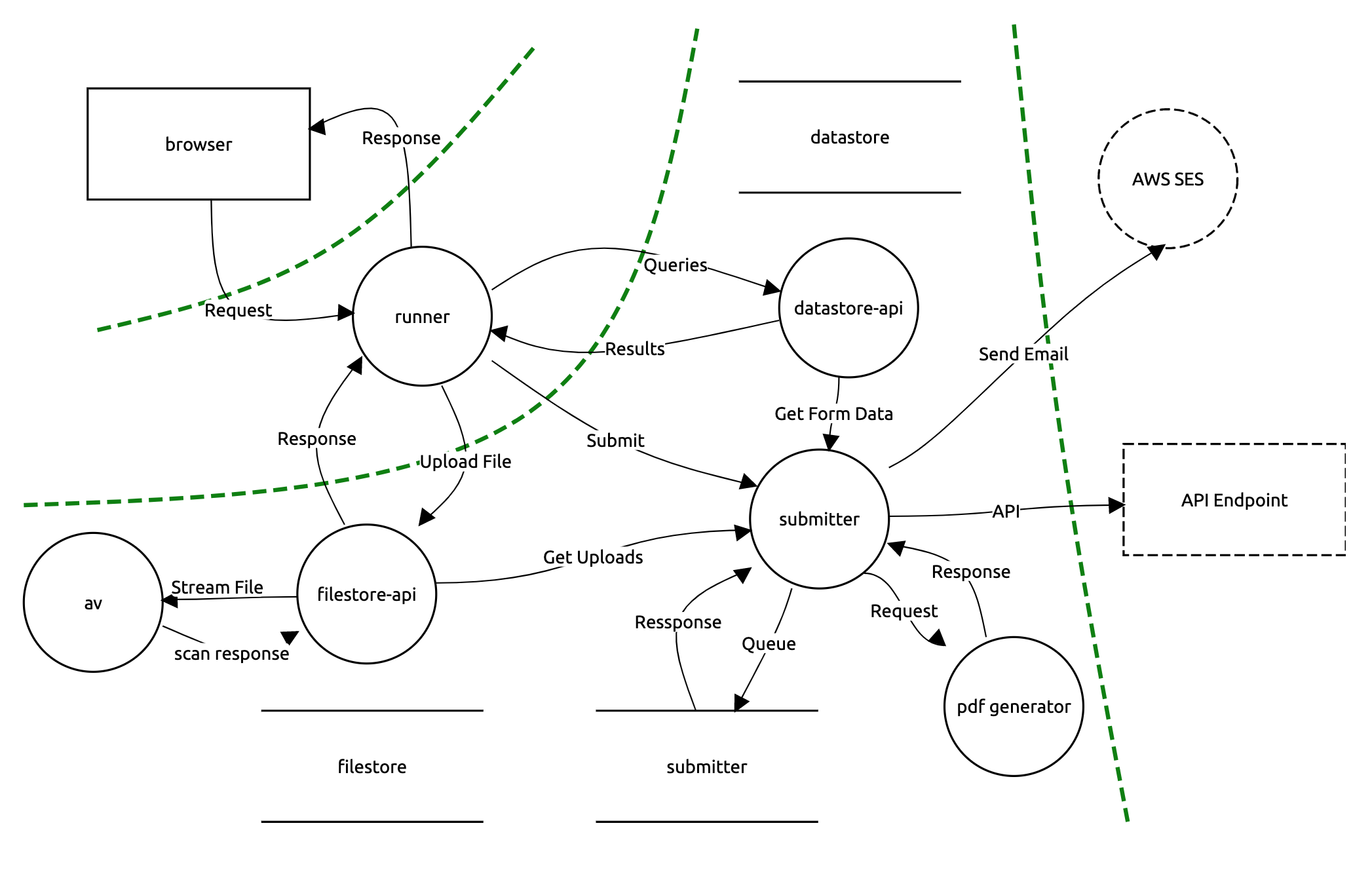Backend Services
User Datastore
Services deployed using MOJ Forms/ Formbuilder require a component to store data submitted by their users in a secure way. There is an suitable implementation agreed with the Information Security team, discussed in detail in an internal document Runner / User data store Threats & Mitigations.
Technology
- PostgrSQL RDS
- API workers, Ruby on Rails
Repositories
- fb-user-datastore
- internal link: fb-user-datastore-deploy
JWT authentication
Each request will be timestamped and signed using a per-service serviceToken (generated by Publisher and injected into the service’s Runner as an environment variable).
User FileStore
The User Filestore is a service for storing files uploaded by users for the lifetime of their application.
It is comprised of an API service and a storage service (Amazon S3).
The service:
- is transient
Files are stored for the same length of time as the user’s other data held in the User Datastore
28 days by default
- is not for making files available either publicly or to final intended recipients
Files can only be retrieved from storage through the API
- is secure
Files are stored encrypted so that files cannot be accessed if the collection is backed up/moved elsewhere
- controls access
Files are stored using a key generated from a digest of the service, user id and file’s fingerprint encrypted with the user’s id/token digest
Files can only be retrieved when presented with all those pieces.
Signing requests
Requests should be signed with JWT, see section below.
Checking additional requirements
Requests should be checked for the presence of encrypted_user_id_and_token (as property for POST, x-header for GET)
- Error if
encrypted_user_id_and_tokenproperty is not present- code:
403 - name:
forbidden.user-id-token-missing
- code:
Creating S3 key
- Create digest from user id + file fingerprint (no service token)
- Encrypt digest via AES-256 with the encrypted_user_id_and_token as key
- Base64 encode the digest
- Key is {user_id}{hashed_digest} (no / in between and no service_slug)
The difference is only for the name of the file that resides on S3.
Store file
POST /service/{service_slug}/{user_id}
{
"iat": "<integer> unix_timestamp",
"encrypted_user_id_and_token": "<encryped_string> userId+userToken encrypted via AES-256 with the serviceToken as the key",
"file": "<binary>",
"policy": {
"allowed_types": [
"<string> mediatype"
],
"max_size": "<integer> bytes",
"expires": "<integer> days"
}
}
A. As per “Check request correctly signed and meets requirements”
B. Check file
- Perform size check if
policy.max_sizeis present- Error if file is too large
- code:
400 - name:
invalid.too-large - max_size: {max_size}
- size: {file_size}
- Perform file type checks if
policy.allowed_typesis present- Error if file is wrong type
- code:
400 - name:
invalid.type - type: {file_type}
- Send to virus scanning service
- Error if file contains virus
- code:
400 - name:
invalid.virus - virus_name: {virus_name}
C. Store file
- Fingerprint file
- Create S3 key
- Encrypt file using
encrypted_user_id_and_tokenas key - Upload file to S3 key
- Error if file cannot be stored
- code:
503 - name:
unavailable.file-store-failed - [service_code]
- [message] ‘any additional info from S3 request’
D. Return file storage details
{
"url": "/service/{service_slug}/{user_id}/{fingerprint}",
"size": "<integer>(bytes)",
"type": "<string>(mediatype)",
"date": "<integer>(unix_timestamp)"
}
Status code if no file previously existed
201(Created)
Status code if a file previously existed
204(No Content)
This information is stored in the User Datastore and is sent to the Submitter to retrieve the file.
Retrieve file
GET /service/{service_slug}/{user_id}/{fingerprint}
encrypted_user_id_and_token must be sent as an x-header.
A. As per “Check request correctly signed and meets requirements”
B. Fetch file
- Create S3 key
- Fetch file
- Error if file cannot be fetched
- code:
503 - name:
unavailable.file-retrieval-failed - [service_code]
- [message] ‘any additional info from S3 request’
- Error if file does not exist
- code:
404 - name:
not-found
- Decrypt file using
encrypted_user_id_and_tokenas key
C. Return file
Return file as body of repsonse
Technology
- Ruby on Rails
Repositories
- fb-user-filestore
- internal link: fb-user-filestore-deploy
Service Token Cache
The services which make up the platform communicate and verify that they can do so. All requests use a signed JSON Web Token (JWT) with the corresponding service’s service token.
Flow for using the Service Token cache
App A - for example the Runner
Encrypts payload
Encodes a JWT and signs with the private key
Sends to App B (Datastore)
Decodes the token, get the service slug
Requests the Service Token Cache for the public key of App A - requests from k8s if it needs to
Verify the signature of the JWT
All okay, continue the request
Error then return a 401 Unauthorised (hash is wrong) or 422 Unprocessable Entity (payload error)
Antivirus
Proves uploaded document scanning.
Technology
- ClamAv
Repositories
- fb-av
- internal link: fb-av-deploy

